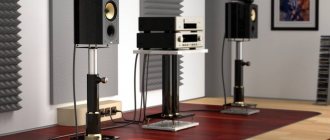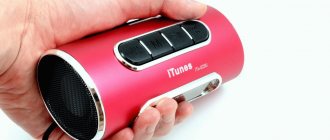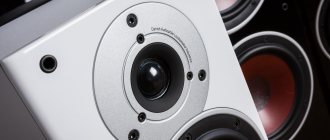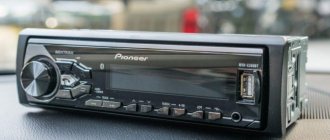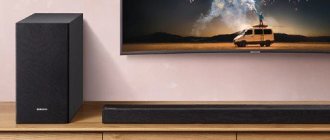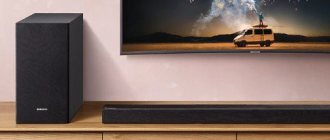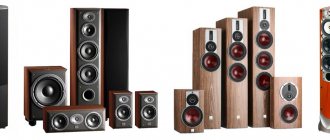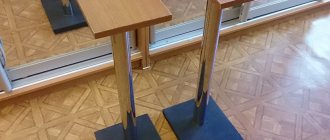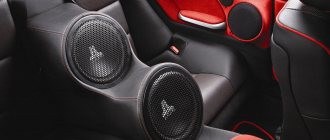KEF Q series (part one)
Read this article in the September issue of Total DVD magazine
Mid-range acoustic systems from a well-known manufacturer
Having tested the junior Cresta line, and the next one - Coda, we could not help but test the company's most famous line - the Q series, which uses famous coaxial drivers, the manufacturing philosophy of which has contributed to no small extent to strengthening KEF's position among the most famous manufacturers of speaker systems .
The company has quite a few speakers that use the proprietary UniQ speaker design concept: from the expensive top-end Reference to the miniature KHT-2005. Of course, the dynamics of these speakers are united only by the concept - the implementation is completely different. This article will focus on middle-class acoustic systems - Q series. This is far from the first generation of these speakers, so we have the opportunity to consider a relatively recent product (the current generation of the Q series appeared a little over a year ago).
The speakers arrived to us for testing not in the usual Q series finish (wood), but in silver. According to the official distributor (Tria), KEF, which previously produced the Q series only with a wooden finish, “broke” precisely under the pressure of requests from Russia - we really love everything silver. And now metallic color has become the fourth standard color for the Q1, Q5 and Q9c models. The other three are “dark apple”, “maple” and “ebony”. By the way, metallic color is not yet available for other Q series models.
The design of the Q-series speaker systems is quite unusual, since there are not many straight panels in the cabinet design: back, top and bottom. But the front and side panels are curved. Without a doubt, the developers pursued primarily the goal of reducing parasitic resonances inside the case by increasing its rigidity, and only then the design. The validity of this statement will become obvious as you read the article, namely, the analysis of the internal structure of the case.
Another characteristic feature of all speakers in this series is a polymer “cap” with the inscription “Q series” embossed on it (see photo above), located on the top panel of the speaker. This cap covers the slightly protruding edge of the UniQ speaker.
The speaker, by the way, is very unusual. This is precisely the main “highlight” of the Q-series speakers. This driver is designed according to the UniQ concept - a patented development of KEF. The concept is based on the desire to create a point source of sound, as a result of which the speakers will “disappear” (will not be localized by ear) - only sound will remain. That is, the listener will not have the feeling that the sound is “sitting” in the speakers. In addition, due to the close location of the midrange and high-frequency speakers, it will be possible to significantly cope with the phase shifts that often arise when using the traditional scheme of separate arrangement of midrange and high-frequency speakers, which will allow more than one person to listen to the sound without loss of the stereo effect. This is roughly how KEF engineers described the essence of UniQ. Well, the statement is quite bold, especially considering that the most affordable Q1 bookshelf speakers cost about $380, while the UniQ speakers used in all Q-series speakers are exactly the same: model B160 SP1485 manufactured by KEF. What we mean is that in this price range it can be difficult to develop engineering ideas due to strict price restrictions. However, we will not draw any conclusions until we listen with our own ears.
Structurally, this driver consists of two completely independent speakers: bass/midrange with a 160 mm polymer diffuser and a tweeter with a 19 mm aluminum dome, located coaxially. This means that the woofer/midrange speaker is made in the form of a donut, the void in the center of which is occupied by the tweeter. For clarity, we decided to take a few photographs of this speaker, so as not to dwell on its description in the future.
The aluminum dome of the tweeter has a suspension made of impregnated fabric and is loaded on a fixed metal horn.
Both speakers are connected independently of each other, for which 2 pairs of terminals are provided. As with traditional (separately located) speakers, the UniQ driver uses an external crossover filter, but in this case the crossover frequency is unusually high: 2.8 kHz.
The terminal block used in all Q-series speaker systems, without any changes, was migrated here from Coda and Cresta speakers (only the inscriptions have changed, of course). In general, these are quite decent terminals with steel screw connectors that allow bi-wiring connections. Of course, you can use not only bare cable, but also banana and even spade connectors. Quite decent terminals. Of course, such luxuries as plastic protection, gold plating, additional grooves on the contact plate and a clamping nut, which can be found on WBT terminals installed on some speaker models in this price category, are not here, however, as we will see later, the developers spent a lot of effort on more important structural elements, having decided to do without unnecessary “show-off” on secondary components of the speaker system. Therefore, such a terminal block can be quite favorably accepted - fortunately, not spring “clothespins”. Mild discomfort is caused only by the squeaking noise from the rubbing metal parts of the connector that is present when screwing in the connectors. Well, okay, it’s quite possible to survive - it’s not fatal.
Now let’s move on to the description of the speaker system models themselves.
KEF Q5
Floor-standing acoustic system with the organization of signal distribution of different frequencies to different dynamic heads according to the “2.5 lane” scheme. This means that the UniQ coaxial driver described above covers the full range of reproduced frequencies, and the additional bass driver only helps it at the lowest frequencies. The Q5 has an acoustic design of a bass reflex with two ports, one of which is located on the front panel: it serves the main section of the speakers (that is, the UniQ coaxial driver). The second port, of a very unusual shape, is located on the rear panel of the speaker. It is designed for more efficient operation of the additional bass driver.
The manufacturer allows you to change the type of acoustic design using two plugs (one for each port) in order to optimize the sound of the speaker system in the conditions of a particular listening room. In addition to the plugs, the box also contains a brief description with the characteristics of the model, as well as a set of studs with washers and locknuts.
In fact, Q5 can be compared to the bookshelf Q1, only working in tandem with passive subwoofers. This comparison is also supported by the design: 2.5-way, not three-way, where the additional bass driver would not help the main UniQ driver, but would take over all the low frequencies, leaving only the mid-frequency and high-frequency ranges for the UniQ.
It cannot be said that the “some and a half bands” scheme is very popular with many English speaker manufacturers, since it is believed that a certain frequency range will be reproduced more correctly if it is provided to one driver, rather than “tearing” the range into two (three) , four) parts, providing each of the bottom with a separate dynamic head. In this case, the bass, in theory, should be more even (the main driver is still the same: coaxial UniQ), and the depth of the bass should not be disappointing - thanks to the additional bass driver. But, again, this is still in theory - the audition is still ahead.
Once again I would like to remind you that the main thing is not the concept itself, but its practical implementation. And here we can give many examples of successful-sounding speakers, both with auxiliary speakers (circuit “1.5 lanes”, “2.5 lanes”, etc.) and with replacement speakers (circuit “2 lanes”, “3 lanes” " etc.).
The presence of two phase inverter ports is not at all accidental. The fact is that each port works strictly for its own speakers. How did you achieve this? Very simple. Inside the Q5 cabinet, a continuous transverse bulkhead was installed, separating the main full-range section from the auxiliary bass section. So it turned out that, in fact, the shelf Q1s were perched on a passive subwoofer - the result was Q5. Of course, the volume of the main section (the one conventionally called Q1) is somewhat smaller than that of the real Q1, because now it is not necessary to ensure good reproduction of the deepest bass in the main section - the additional section, which is almost twice as large in volume, will do this perfectly.
In addition to the solid bulkhead, in the Q5 hull you can see several ties (or stiffening ribs - whatever you like) that prevent the hull walls from “singing along” (the appearance of internal hull overtones). The case is filled with a sound absorber (sintepon), which we removed while filming the “abdominal cavity” of the speaker.
All hull panels, bulkheads and ties are made of MDF of varying thickness (from ~1 to ~2.2 cm). The panel joints are carefully sealed. It is curious that the curved side walls of the case did not become this way during the bending process (as, for example, in the KEF PSW-2500 subwoofer - due to parallel grooves in the MDF sheet), but were originally made as such. That is, the body panels were not cut from a large, flat sheet of MDF, as is often the case. For the side panels, special pressing molds were made, which made it possible to obtain an initially curved sheet - this is not a cheap undertaking, especially considering the final cost of the same Q1, which also uses these shaped side panels.
| KEF Q5 | |
| Technical characteristics (passport) | |
| Acoustic design | Bass reflex (port on the front and rear panels) |
| Recommended amplifier power | 15 - 150 Watt |
| frequency range | 39 Hz - 27 kHz (± 3 dB) |
| Sensitivity | 91 dB |
| Resistance | 8 ohm |
| Filter cutoff frequency | 2.8 kHz |
| Dynamic emitters | LF: cone diffuser (165 mm in diameter) made of polymer |
| Coaxial UniQ driver: HF - dome diffuser (19 mm in diameter) made of aluminum; Midrange is a conical diffuser (165 mm in diameter) made of polymer. | |
| Terminals | 2 pairs of banana jack screw terminals |
| Magnetic shielding | Yes |
| Are common | |
| Housing material | MDF |
| Dimensions (H×W×D) | 912×232×337 mm |
| Weight without packaging (pcs.) | 14.5 kg |
| Approximate price | $940 (pair) |
Measurement results
We would like to remind you that frequency response and distortion graphs cannot fully characterize the sound of speakers. They only allow you to roughly estimate the nature of the sound, as well as identify obvious advantages/disadvantages. That is why measurement graphs should be taken only as an addition to the listening results, because detailed listening is the first and main test when choosing any audio equipment and speaker systems.
The frequency response graph shows slight irregularities at medium and high frequencies. A more significant increase in frequency response differences is observed only in the lower middle region.
Increases in the frequency response in the area of 150, 420 and 550 Hz can theoretically cause a slight “booming” effect in the sound of some instruments.
The level of distortion is very small: in the range of 250 Hz - 6.5 kHz it does not exceed 0.5%, and after 6.5 kHz it generally goes beyond the boundaries of the graph (that is, 0.1% and below). A relatively small peak (slightly more than 1%) is observed around 170 Hz, and as the frequency decreases (40 Hz and below), distortion traditionally increases, but even at the very bottom its level does not exceed a few percent. That is, in general, the level of distortion can be called very low.
Measurements at an angle of 45° in the horizontal plane show, although not a strong, but still an increase in the unevenness of the frequency response, so it is better to orient the speakers when listening directly to the listening position.
KEF Q1
Two-way bookshelf speaker system. The design uses one UnQ coaxial driver - exactly the same as we saw in the Q5 model. Of course, there is no additional bass driver.
By the way, a little noticeable fact: the Q1 case has a slightly smaller width than the Q5 case. This indirectly indicates that from Q5, they created a completely new speaker. The terminal block is the same as the rest of the Q series speakers. The kit includes a plug for the bass reflex port.
When describing the Q5, we completely lost sight of the design of the grill (protective grille), which is the same for all Q series speaker systems, differing only in shape. The grill is a fabric stretched over a plastic grill with a very bizarre pattern of interlacing “rods”. As for the fabric, it is a relatively thick material that is supposed to be acoustically transparent, but we have our doubts about this. The fabric, coupled with the rather sparse frame rods, still forms some kind of obstacle to sound. I'll have to listen to the speakers with and without grills. The fastening of the grille to the body is quite traditional: through vibration dampers, as it should be.
| DKEF Q1 | |
| Technical characteristics (passport) | |
| Acoustic design | Bass reflex |
| Recommended amplifier power | 15 - 120 Watt |
| frequency range | 45 Hz - 27 kHz (± 3 dB) |
| Sensitivity | 91 dB |
| Resistance | 8 ohm |
| Filter cutoff frequency | 2.8 kHz |
| Dynamic emitters | Coaxial UniQ driver: HF - dome diffuser (19 mm in diameter) made of aluminum; Midrange is a conical diffuser (165 mm in diameter) made of polymer. |
| Terminals | 2 pairs of banana jack screw terminals |
| Magnetic shielding | Yes |
| Are common | |
| Housing material | MDF |
| Dimensions (H×W×D) | 355×222×326 mm |
| Weight without packaging (pcs.) | 6.4 kg |
| Approximate price | $380 (pair) |
Measurement results
The nature of the frequency response and distortion is in many ways similar to the results shown by Q5, which is not surprising. Since the body of Q1 is still slightly different in volume and shape than the upper section of Q5, the unevenness of the frequency response graph in this case is different. The level of distortion has increased very slightly (fractions of a percent), but there is no peak at the border of the lower middle and midbass, which was the case with the Q5.
KEF Q9c
Speaker of the central channel. Two-way speaker of bass reflex type. Of course, the Q9c uses exactly the same UniQ coaxial driver as other Q series speakers.
The speaker housing has a horizontal layout. now there are two, since the height of the case is relatively small and the speaker extends beyond the edges of the case not only at the top, but also at the bottom. The speaker is placed on 3 rubber supports: 2 in front, one in the rear of the case. The Q9c can be installed on any flat surface, even one that is not completely parallel to the ground. The fact is that the rear leg is a large rotating bolt with a rubber attachment on the head. Thanks to this design, it is possible to slightly adjust the tilt of the body in the vertical plane (approximately ±10°), thereby ensuring the desired focus of the speaker on the listeners, even if the central speaker is, for example, on a slightly sloping top panel of the TV.
The cabinet structure also uses curved MDF panels and internal MDF ties. The front panel is made of a combined material: a “sandwich” of pressed cardboard and MDF. The interior space is also filled with a sound absorber, which we, of course, pulled out. But then they put it back. Honestly
| KEF Q9c | |
| Technical characteristics (passport) | |
| Acoustic design | Bass reflex |
| Recommended amplifier power | 15 - 120 Watt |
| frequency range | 50 Hz - 27 kHz (± 3 dB) |
| Sensitivity | 91 dB |
| Resistance | 8 ohm |
| Filter cutoff frequency | 2.8 kHz |
| Dynamic emitters | Coaxial UniQ driver: HF - dome diffuser (19 mm in diameter) made of aluminum; Midrange is a conical diffuser (165 mm in diameter) made of polymer. |
| Terminals | 2 pairs of banana jack screw terminals |
| Magnetic shielding | Yes |
| Are common | |
| Housing material | MDF |
| Dimensions (H×W×D) | 209×480×296 mm |
| Weight without packaging | 6.2 kg |
| Approximate price | $390 |
In general, the situation with the price of the Q9c surprises many, because one Q9c center channel speaker costs more than a pair of Q1 bookshelf speakers. Yes, the Q9c has a slightly more complex body design, but it uses only one UniQ speaker (the Q1 pair has two, respectively), and it will still take less lumber than it would take to make two Q1 bodies. Therefore, it is unclear why KEF is asking more for the Q9c than the cost of a pair of Q1 speakers.
This is if you look at it from one side. But there is another thing: it’s not the central speaker that is overpriced, but Q1 simply has a relatively low price. The second point of view is more logical, since the Q1 bookshelf units cost $380, while the Q3 model (the same Q1, only in a floor-standing version - the only difference is the increased volume of the case) is already $600. And the Q5 model (a woofer is added, a slightly more complex body is used, compared to the Q) - already $940. That is why the cost of the Q9c fits into the overall price picture, unlike the Q1, which, given the general nature of prices for Q-series speakers, in theory should have cost just over 400.
Measurement results
Well, the frequency response is noticeably smoother in the mid and high frequencies. The irregularities in the lower middle still remain. The nature of the distortion has also remained virtually unchanged compared to Q1.
Sound in music
Listening was carried out using an AV receiver NAD T-752 and Sherwood RD-6318
Once connected (and we listened to music on both the Q5 and Q1), we, as usual, pay some attention to the optimal placement of the speakers and determining the seating position of the listeners. It turned out the following: for a comfortable perception of the sound, it is desirable to ensure a low seating position (low chair or sofa): in this case, the sound seemed more “open” and “alive”. It is better to place the speakers according to the classic “isosceles triangle” scheme, where the distance between the speakers is slightly less than the distance from the listener’s head to the front line on which the speakers are located.
As for the gags for the bass reflex ports, in a quiet room with an area of ~25 m², we considered it optimal to mute the lower rear port of the bass driver, leaving the upper port on the front panel open. Although, a lot here depends on the listening room, so you, dear readers, are better off experimenting yourself directly in a specific listening room.
So, according to tradition, immediately after the “warm-up” (about an hour of getting used to the sound), we listened to acoustic music: jazz, jazz-rock, classical (symphonic, opera, chamber music), fusion. From the very first minutes, the KEF Q5/Q1 showed themselves to be very dynamic and impressive-sounding speakers with a good, clear attack and absolutely stunning sound from the foreground instruments, which usually turn out to be either soloists or virtual sound stage performers located in close proximity to the viewer. We enjoyed the music openly for a while, but then we began to notice hidden aspects of the sound. First of all, I would like to note the slight coloration of high frequencies, which gives the sound of many brass drums and high-frequency percussion (maracas, bells, etc.) some similarity. So, for example, we listened to several jazz compositions by different artists, and it seemed that the hi-hats in many cases were very similar in timbre to each other. Otherwise, I liked the high frequencies for their purity and unobtrusiveness.
The tonal balance can be assessed as moderate, since we did not notice any obvious “distortions”. The timbres of complex instruments are reproduced very beautifully and effectively, with a considerable number of overtones and nuances, although not in all cases the timbres were easily recognizable: the speakers still interpret the sound a little differently, which, however, did not interfere with the comfortable perception of the sound.
The sound has slight accents in the lower mids and moderate high frequencies. It was also noticed that despite the very effective performance of the near-field parts and the precise positioning of the solo instruments in space, the speakers formed the far space (the depth of the sound stage) somewhat blurrily: the instruments sound clearly, but where exactly in space the musician sits is sometimes difficult to understand. Now one more thing: listening to the speakers without a protective grille really proved that the grill still somewhat degrades detail and slightly distorts the tonal balance, so it is better to remove it immediately. This is for the better, because without grills the speakers look much more elegant.
Next on the list was modern music (rock, dance, electronic). Here the speakers showed that, although they have a very universal (in terms of music genres) sound, the speakers clearly liked catchy jazz-rock (Scott Henderson) and melodic rock and blues (Dire Straits). The sound has noticeably changed: the tonal balance has become more “open”, the characteristic high frequencies practically no longer distract attention, and we have completely forgotten about the formation of stage depth, because there is no such strong sense of the space of a concert hall in modern music. For comfortable reproduction of rock, I would like a little less emphasis on the mid-highs, but otherwise it’s very good. As for the mid-highs, I’m sure that this can be “treated” by selecting an amplifier “to taste.”
Finally, the differences in sound between the Q5 and Q1 came down mainly to the more powerful and deeper bass of the Q5 model. By the way, the Q5 model should not be used in rooms smaller than ~18 m², since a fairly powerful bass will simply “clog” the other ranges - the “transparency” of the sound will also suffer, and therefore the listening comfort.
Sound in the theater
There is no point in saying too much here. Good dynamics and a clear attack ensured the correct transmission of ringing and biting sounds, and the use of identical drivers in all speakers made it possible to very accurately coordinate the speakers with each other. In general, the KEF Q series performed very well in the theater. The only point: at high volumes the speakers started to “scream”, so you shouldn’t install the KEF Q5/Q1/Q9c in rooms with an area of more than 30 m².
Conclusion
These stylish acoustic systems pleased us with their competent design, abundance of finishes and the ability to adjust the sound to the listening room. The sound of the KEF Q has its own character, but this interpretation of the sound does not cause discomfort, allowing you to listen to a wide variety of music (especially rock, blues and popular music), and also use these speakers to build home theaters in medium-sized rooms.
KEF Q is exactly the case when you shouldn’t buy speakers “blindly”: if the sound of the speakers has its own character (this is what is called “signature sound”), then you need to decide for yourself whether you like this character or not . Unfortunately, these acoustic systems also have several annoying, but not particularly serious, disadvantages. In general, the speakers turned out to be very interesting.
We recommend using the kit in rooms with an area of 18 to 30 m².
pros
- quite universal (in terms of music genres) and exciting sound with good dynamics and clear attack;
- dynamic and clear sound in cinema;
- enviable realism of the sound of the foreground instruments (usually solo);
- high-quality housing design;
- good coordination of all speakers in the theater.
- 4 finishing options.
Minuses
- somewhat peculiar high frequencies;
- unclear depiction of depth, as well as a tendency to somewhat understate the scale of the sound stage;
- The sound changes for the better when the grills are removed.
We thank TRIA International for providing the KEF Q series for testing
KEF IQ50 Floorstanding Speaker
Peculiarities
The KEF iQ50 models are representatives of the next generation of the famous Q-series, the name of which was given by the proprietary Uni-Q coaxial mid/high frequency driver, and the history of which has continued with continued success for more than 20 years. According to the tradition of the latest evolutions, the models of the iQ line are made in two form factors, differing in the width of the housings and, accordingly, the size of the speakers. The larger models in the line are equipped with 165 mm woofers and coaxials; their “younger” sisters, which include the KEF iQ50, have narrow cabinets in a fashionable Slim design and are equipped with speakers with a diameter of 130 mm.
| KEF iQ50 bass reflexBi-Amping/Wiring | |||||||||||||||||||||||||||||||||||
Rated power
| |||||||||||||||||||||||||||||||||||
The familiar exterior features of the new iQ have not undergone significant changes: the same smooth contours of the body, the bass reflex port partially overlapped by the bass speaker, the streamlined “cap” on the top panel, only now it is made not of plastic, but of metal. In general, the Q-series speakers have not lost their recognizable appearance. At the same time, the main design details have changed significantly. The speakers use the latest version of the Uni-Q coaxial module, in which a 19 mm aluminum dome with an elliptical profile is closed with the original Tangerine multi-lobe splitter. The splitter is designed, on the one hand, to expand the directional pattern of sound at high frequencies, on the other hand, it protects the dome well from unpleasant accidents. The modern Q-series woofers have new composite diaphragms, rubber surrounds that provide increased cone travel, and Faraday rings used to reduce harmonic distortion in the magnetic system. By the way, in the KEF iQ50, the mid-frequency driver from the Uni-Q module and the bass speaker together sound the low-frequency range, that is, the speakers have a 2.5-way crossover configuration.
The internal design of the office has also changed. Floor-standing models in the series, including the KEF iQ50, feature a new internal baffle layout that eliminates the sound coloration associated with vertical “standing waves.” On the back of the iQ50 cabinet there is a terminal block with two pairs of connectors that allow connection using Bi-Wiring/Bi-Amping methods; jumpers between the terminals are traditionally made of sections of thick acoustic cable with spade-type connectors. KEF iQ50 cabinets have three vinyl finishes in black ash, dark apple and American walnut. Brief description
The elegant and precise sound of the KEF iQ50 will appeal to fans of jazz, chamber classical and popular music who do not need concert volume levels.
The editors of the online magazine AVREPORT.ru thanks TRIA International, Ltd. for providing equipment for testing. Impression
Like all previous generations of the company's speakers, equipped with coaxial midrange and high-frequency Uni-Q drivers, the tested KEF iQ50 build an excellent, wide and azimuthally detailed musical stage, transparent in volume.
Only the distant plans of the stereo panorama twitch with a slight haze. Otherwise, the “English women” can be praised for their clear, airy top and expressive midrange with nice natural timbres. The play of the soloists' voices, their intonations and emotions are well conveyed. Surprisingly, despite its subtle appearance, the KEF iQ50 have quite deep bass, not limited to just the upper part. Of course, the sound of the speakers below is not extremely dynamic, there are some limitations, but the strict line of the upper bass, along with the clarity and decent control of the mid-bass, is captivating. KEF iQ50 are intended more for medium-sized rooms, because on the one hand they need some distance from the side walls, and on the other hand they do not like loud sound, since in this case excess colors appear in the middle, the intelligibility of treble notes deteriorates, and boominess appears below. In addition, the KEF iQ50 does not play well with all amplifiers; they need a device with good bass damping; with an “unsuccessful” amplifier, the speakers will not show bass control even at moderate volume, or they may focus unnecessary attention on trebles. Measurements The frequency response irregularities of the KEF iQ50 are within +/-4 dB in the frequency range up to 12 kHz. The lower level limit of +/-3 dB is 52 Hz. The uniformity of radiation at different angles from the axis is quite high; even at 30 degrees, there is a noticeable decrease in sensitivity only at frequencies above 15 kHz. Moreover, in the angular direction the frequency response behaves more smoothly at high frequencies, avoiding the tendency for sensitivity to increase in the upper octaves. At medium frequencies, the impedance curve has small kinks, indicating the presence of resonances, the strongest of which appear on the frequency response graph in the form of local increases in sensitivity at 170, 340, 900 Hz. In the 170-470 Hz range, the KEF iQ50's impedance drops below 4 ohms, with a minimum of 3.7 ohms at 280 Hz. The maximum resistance is achieved at a frequency of 1.9 kHz and is equal to 17.7 Ohms. The KEF iQ50 bass reflex is set to a frequency of 45 Hz.
The best KEF speakers: budget, premium, bookshelf and stand
Best KEF Speakers Buying Guide: Welcome to What Hi-Fi?'s review of the best KEF speakers you can buy in 2021.
KEF is one of the finest suppliers of British hi-fi, with a distinguished heritage stretching back over 50 years. He's had a few ups and downs along the way, but he hasn't lost his talent for creating stylish, great-sounding speakers.
Most KEF speakers are equipped with the company's innovative Uni-Q driver. Instead of having a separate tweeter and midrange driver, the tweeter is mounted in the center of the midrange. The idea is simple, but that's what sets the company apart from the rest.
More importantly, KEF keeps up with the times and produces wireless speakers, including Bluetooth desktop speakers and wireless all-in-one systems. one streaming systems such as the excellent LSX (see below).
With more choices than ever, you may be wondering where to start. The good news is that we've done a lot of work and collected the best that KEF has to offer.
- 11 Best KEF Products of All Time
KEF LS50 Meta
These stands set new standards in price.
SPECIFICATIONS
Speaker Connectors: Single | Frequency response: 79-28,000 Hz | Sensitivity: 85 dB/W/m | Dimensions (hwd): 30.2 x 20 x 27.8 cm
Reasons for purchase
Exceptional sound transparency
Subtle and precise presentation
Innovative technology
Reasons to avoid
Nothing at this price
The KEF LS50 Metas are no different from the LS50, and in many ways they are the same. The company considered revisiting this beautifully crafted case, but concluded that little could be improved.
The only area ripe for improvement was the Uni-Q LS50's driver array, where the tweeter sits in the middle throat. /bass block. It has been thoroughly redesigned, taking into account all the improvements KEF has developed over the past eight years and adding something new in the form of Metamaterial Absorption Technology (MAT), KEF's way of dealing with sound coming from the back of the 25mm glass. aluminum tweeter dome.
It doesn't take long to realize that the LS50s have improved significantly. While the underlying sonic character is immediately familiar, the new ones have a crisper, more refined quality that the originals only hinted at.
Read the full review: KEF LS50 Meta
KEF LSX
A superb, rhythmic, all-in-one Hi-Fi system
SPECIFICATIONS
Driver: 11.5cm Uni-Q midrange/woofer with built-in 19mm aluminum dome tweeter | Features: Bluetooth 4.2 with aptX codec, high-resolution audio support | Dimensions: 24 x 15.5 x 18 cm (H x W x D)
Reasons for purchase
Best-in-class insight
Powerful connectivity
Neat, colorful design
Reasons to avoid
Some Application Disadvantages
Despite their sleek size, these powered bookshelf speakers wowed us with their complete, expressive, and rich sound. However, they represent much more than just superior audio quality, as they are also a wireless all-in-one system capable of handling high-resolution files up to 24-bit/192kHz.
They may look like they've been hit by a shrink ray compared to the LS50 wireless speakers, their big brother, but they're no less impressive. Equipped with Uni-Q drivers, a 200W Class D amplifier and a choice of stylish colors that would put Farrow & Ball to shame, they are the best in the KEF class.
Read the full review: KEF LSX
KEF Q350
Elegant, detailed and surprisingly affordable.
Driver: 16.5cm Uni-Q mid/bass with integrated 25mm aluminum dome tweeter | Features: 2-way bass reflex | Dimensions: 35.8 x 21 x 30 cm (H x W x D)
Reasons for purchase
Stunning levels of clarity and detail
Enormous scale of sound
Good synchronization
Reasons to avoid
Lack of energy and drive
Not better at low volumes
Looking for the best floor standing speakers under £500? You've come to the right place. Redesigned to reduce distortion and improve performance, the updated Q350 now offers a winning combination of sleek, sophisticated looks and stunning presence.
Durable, beautifully designed cabinets are available in satin black or white with black or silver Uni-Q speakers. What the Q350 lacks in power, it more than makes up for in clarity, depth and composure. If they are within your budget, this is not a problem.
Read the full review: KEF Q350
KEF R3
Amazing audio performance at a reasonable price
Driver: 16.5cm woofer and 12.5 Uni-Q midrange driver with built-in 25mm aluminum dome tweeter | Dimensions: 42.2 x 20 x 31.2 cm (H x W x D)
Reasons for purchase
Exceptional insight and resolution
Balanced and entertaining sound
Excellent build and finish
Reasons to avoid
Nothing at this price
R3 received our seal of approval back in 2022 thanks to its exceptional level of detail and insight. You'll find them sound balanced and extremely capable. In fact, we think they provide much of the performance of the more expensive R1s, but at a fraction of the cost.
They are brilliant all-rounders and work well with almost any system; give them a decent feed and you'll find they put most competitors under £2,000 to shame. Well designed, excellent value for money and damn stylish to boot.
Read the full review: KEF R3
KEF LS50 Wireless
All-in-One Premium Hi-Fi Streaming System
SPECIFICATIONS
Speaker: 13cm Uni-Q midrange/woofer with 25mm aluminum dome tweeter | Features: Bluetooth 4.0 with aptX, High-Resolution Audio Support | Dimensions: 30 x 20 x 30.8 cm (H x W x D)
Reasons for purchase
Excellent clarity
Impressive bass and dynamics
Superb build quality
Reasons to avoid
Could be more convenient
This impressive all-in-one streaming music system is a larger and more powerful variant of the KEF LSX. The sound quality is nothing short of craftsmanship, simplicity and maturity, especially when it comes to complex dynamic shifts.
They may be designed for the digital age, but KEF hasn't abandoned its hi-fi pedigree, so you can count on a good selection of analogue inputs. Like most wireless powered speakers, they are not truly "wireless": both the master and slave speakers must be connected to mains power, with a cable running between them. But it's a small price to pay for this level of performance in a sleek and stylish package.
Read the full review: KEF LS50 Wireless
KEF R5
These floorstanding speakers are classy and sophisticated performers
Driver: 2 x 13cm LF and 12.5cm Uni-Q mids with built-in 25mm aluminum dome tweeter | Features: Two-wire connection | Dimensions: 103 x 18 x 34 cm (H x W x D)
Reasons for purchase
Fun and sophisticated sound
Good detail and seamless integration
Excellent stereo imaging
Reasons to avoid
Lacking the dynamic finesse of the best
Impeccably built, elegantly designed and loaded with innovative features, it's clear that a lot of work has gone into creating the KEF R5. You get two woofers above and behind the Uni-Q midrange, both paired with a tuned reflex port, so you can imagine how much heft these floor-standing speakers can pack.
But that's not true. It's just that power is on their side R5. Brilliant detail and superb stereo imaging are offered, and all of these drivers integrate perfectly for a smooth and controlled presentation.
Read the full review: KEF R5
Link KEF 1
Proof that British hi-fi rocks
SPECIFICATIONS
Driver: 16.5 cm LF and 12.5 cm Uni-Q mids with built-in aluminum dome tweeter 25 | Features: Three-way bass reflex | Dimensions: 44 x 20.5 x 43 cm (H x W x D)
Reasons to buy
Sound authority and composure
Revealing but unpretentious
Impressive engineering and stunning build
Reasons to avoid
Cost of dedicated stands for reference 1
Ready to blow your budget? The Reference 1s deliver immersive, beautifully layered sound that will elevate and enhance virtually any composition. The bass is a particular highlight: refined yet punchy, highlighting KEF's talent for precisely balancing firepower.
Some high-quality speakers tend to be suitable for a certain genre of music, but this is not the case with Link 1c. They're stellar all-rounders, aren't too picky about positioning, and are built to KEF's exacting standards. If you have a healthy bank account, they are worth every penny.
Read the full review: Link 1 KEF
KEF Egg
Tabletop Egg Speakers
SPECIFICATIONS
Driver: 16.5cm Uni-Q mid/bass with built-in 25mm aluminum dome tweeter | Features: Bluetooth 4.0 with aptX | Dimensions: 27.4 x 13.6 x 17.2 cm (H x W x D)
Reasons to buy
Very good integration
Balanced sound
Universal
Reasons to avoid
3.5mm input could be neater
These whimsical miniature wonders are KEF's unique take on desktop speakers. They work equally well as wireless or wired speakers, making them a true jack of all trades. And because they come with a built-in 50W amplifier, they have the power you need to enhance the sound of your laptop or TV.
When it comes to sound dispersion, the Eggs are no yolk, creating a surprisingly lively and immersive soundstage. Assuming their retro 1960s sci-fi movie look doesn't scare you, Eggs is a great buy.
Read the full review: KEF Egg
- How to Choose the Right Speakers, Part One: Research
- How to Choose the Right Speakers, Part Two: Buying
- How to choose the right speakers, part three: -up kit
ENTER THE SITE
It turns out that there is no escape from the multi-way speaker design, but this approach has its drawbacks. Firstly, in the crossover zone, the small tweeter and the mid-bass speaker, as a rule, have different directions, and the listener, moving away from the axis of the speaker system, will feel changes in the tonal balance of the sound. Secondly, interference from speakers in crossover areas can result in audible distortion. Third, physically separating the drivers on the front panel can disrupt phase matching, since the sound from the speakers will not arrive at the listener's ears at the same time. Of course, manufacturers have known about these problems for a long time and have been fighting them. For example, phase matching can be improved by bringing the midrange/high-frequency loudspeakers closer together and/or placing them coplanarly (in the same plane); another option is coaxial placement of the tweeter on the axis of the midrange driver. When developing Uni-Q, KEF engineers combined the above-mentioned approaches: the tweeter and midrange driver (or mid-woofer, depending on the speaker configuration) are located relative to each other at the same time both coplanar and coaxial. Simply put, the Uni-Q multiband drivers have the same acoustic cents. This design automatically provides several advantages: precise phase matching of the drivers and identical directivity, due to the fact that the midrange cone becomes an acoustic lens for the tweeter. The crossover circuit is further simplified, allowing engineers to focus on smooth frequency matching of the drivers in the module. As a result, we have the very desired point source of sound!
Direction among audio engineers is usually denoted by the letter “Q”, and “Uni” comes from the English word “unified” - unified, united. Now it’s clear where the name of the technology comes from: Uni-Q means equal direction.
The elegant solution of the KEF engineers looks trivial and raises the question of why no one thought of making co-incident (in phase) emitters before them. Everything is not as easy as it seems. Although Uni-Q's technology promised big wins, engineers faced some challenges. Let's start with the fact that the designers had to find a way to fit a pair of emitters into the size of one without sacrificing sound quality. And the fact that the mid-frequency membrane serves as an acoustic lens for the tweeter dome is not only an advantage, but also a disadvantage, because the “lens” is not static, it moves. In such a situation, the profiles of the midrange driver diffuser and its suspension, the design of the “mouth” into which the HF head is inserted, have a noticeable effect on the character of the sound of the upper frequencies, causing undesirable sound colors.
